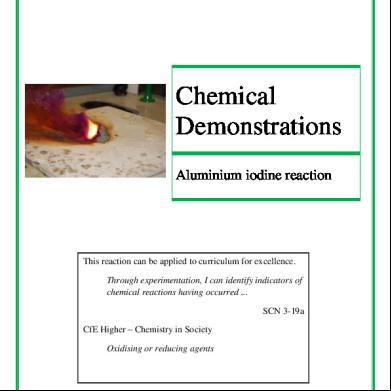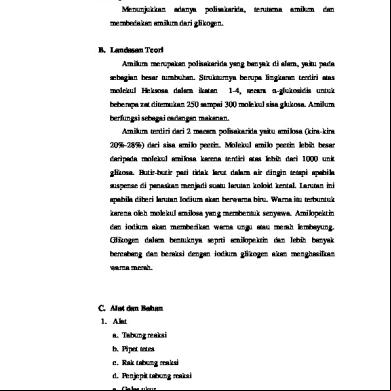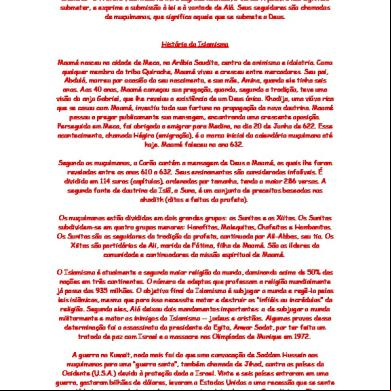Aluminium Iodine Reaction 3a5x56
This document was ed by and they confirmed that they have the permission to share it. If you are author or own the copyright of this book, please report to us by using this report form. Report 3b7i
Overview 3e4r5l
& View Aluminium Iodine Reaction as PDF for free.
More details w3441
- Words: 596
- Pages: 3
Chemical Demonstrations Aluminium iodine reaction
This reaction can be applied to curriculum for excellence. Through experimentation, I can identify indicators of chemical reactions having occurred ... SCN 3-19a CfE Higher – Chemistry in Society Oxidising or reducing agents
Introduction The chemical properties of iodine are very similar to those of bromine and chlorine. It is, however, much less reactive. It can also act as an oxidising agent that can reduce a number of elements such as phosphorus, aluminium, zinc and iron Usually, though, high temperatures are required. Aluminium, despite its normal inert behaviour, is a very reactive metal. The inactivity that is normal is due to a generally impermeable layer of aluminium oxide on the surface. The oxidation of finely powdered aluminium by iodine can be started by simply using a few drops of water, which starts a spectacular reaction that produces clouds of purple smoke. You will need 0.5g Aluminium powder (fine) Pipette with warm water Access to a fume cupboard
Iodine (solid) 2g Metal tray or tin lid Heat proof mat
To do a. Grind up the iodine with a pestle and mortar. b. Carefully mix the iodine with the aluminium powder. c. Place the mixture in a pile in the tin lid and make a small dent in the top of the pile. d. Place the lid with the mixture on it in on a heat proof mat in a fume cupboard. e. Use a pipette to add two or three drops of water to the top of the pile. f. There will be a delay, usually of around 15 – 30s and then clouds of purple iodine vapour will start to appear. g. The mixture then bursts into flame producing white smoke along with the purple iodine vapour. It soon goes out to leave a glowing white residue of aluminium iodide.
Health and Safety Iodine vapour is harmful (Cat 4) by inhalation and by skin . Wear gloves and eye protection. Carry out the experiment in a fume cupboard.
Disposal Allow the residue to cool. Then add it to 1 M sodium carbonate solution. Add it a bit at a time and allow the frothing to go down before the next addition. Once it is all finished, the mixture can be washed to waste with large quantities of cold water.
Notes It is important to try this experiment with the bottle of aluminium powder that you will be using before doing it as a demonstration. Different samples of aluminium powder can react differently. If the powder is too coarse, it may not work at all. The induction period for the reaction can be quite long. If it does not work, add another couple of drops of water. Adding a drop or two of detergent to the water will help with the wetting and speed up the incubation period of the reaction. If the reaction is not initiating, leave it in the fume cupboard, which should be switched on, until you have time to clear it up. DO NOT leave it in the open lab. It has been known for these mixtures to suddenly react after a very long delay. If this happens in an open lab, the entire room could be coated with iodine and become unusable. The Chemistry The reaction is: 2Al(s) + 3I2(s) → Al2I6(s) It is catalysed by water. The anhydrous iodide produced here, reacts vigorously with water, sometimes violently if freshly prepared and still hot, releasing fumes of hydrogen iodide. The heat produced by this exothermic reaction causes some of the solid iodine to sublime into purple vapour.
This reaction can be applied to curriculum for excellence. Through experimentation, I can identify indicators of chemical reactions having occurred ... SCN 3-19a CfE Higher – Chemistry in Society Oxidising or reducing agents
Introduction The chemical properties of iodine are very similar to those of bromine and chlorine. It is, however, much less reactive. It can also act as an oxidising agent that can reduce a number of elements such as phosphorus, aluminium, zinc and iron Usually, though, high temperatures are required. Aluminium, despite its normal inert behaviour, is a very reactive metal. The inactivity that is normal is due to a generally impermeable layer of aluminium oxide on the surface. The oxidation of finely powdered aluminium by iodine can be started by simply using a few drops of water, which starts a spectacular reaction that produces clouds of purple smoke. You will need 0.5g Aluminium powder (fine) Pipette with warm water Access to a fume cupboard
Iodine (solid) 2g Metal tray or tin lid Heat proof mat
To do a. Grind up the iodine with a pestle and mortar. b. Carefully mix the iodine with the aluminium powder. c. Place the mixture in a pile in the tin lid and make a small dent in the top of the pile. d. Place the lid with the mixture on it in on a heat proof mat in a fume cupboard. e. Use a pipette to add two or three drops of water to the top of the pile. f. There will be a delay, usually of around 15 – 30s and then clouds of purple iodine vapour will start to appear. g. The mixture then bursts into flame producing white smoke along with the purple iodine vapour. It soon goes out to leave a glowing white residue of aluminium iodide.
Health and Safety Iodine vapour is harmful (Cat 4) by inhalation and by skin . Wear gloves and eye protection. Carry out the experiment in a fume cupboard.
Disposal Allow the residue to cool. Then add it to 1 M sodium carbonate solution. Add it a bit at a time and allow the frothing to go down before the next addition. Once it is all finished, the mixture can be washed to waste with large quantities of cold water.
Notes It is important to try this experiment with the bottle of aluminium powder that you will be using before doing it as a demonstration. Different samples of aluminium powder can react differently. If the powder is too coarse, it may not work at all. The induction period for the reaction can be quite long. If it does not work, add another couple of drops of water. Adding a drop or two of detergent to the water will help with the wetting and speed up the incubation period of the reaction. If the reaction is not initiating, leave it in the fume cupboard, which should be switched on, until you have time to clear it up. DO NOT leave it in the open lab. It has been known for these mixtures to suddenly react after a very long delay. If this happens in an open lab, the entire room could be coated with iodine and become unusable. The Chemistry The reaction is: 2Al(s) + 3I2(s) → Al2I6(s) It is catalysed by water. The anhydrous iodide produced here, reacts vigorously with water, sometimes violently if freshly prepared and still hot, releasing fumes of hydrogen iodide. The heat produced by this exothermic reaction causes some of the solid iodine to sublime into purple vapour.










